kevryan
Kevin joined
Was one of the owners of Dynamix. Created Arctic Fox for the Amiga computer (published by Electronic Arts). Was fun to wander around around EA's office after hours when visiting. They had a Marble Madness machine - no quarters needed.
I was the designer and programmer of The Incredible Machine series of games. Now I live high up in the Sierra Nevada mountains of California and am the Founder and Creative Director at Top Meadow Inc where I continue to create games.
A few of my past game titles are Arctic Fox, Skyfox II, F-14 Tomcat, Heart of China, Rise of the Dragon, The Incredible Machine, 3D Ultra Minigolf, Marble Blast, and Contraption Maker which were published by various companies including Electronic Arts, Activision, and Sierra
The Incredible Machine (TIM) is a computer game released in 1992 that is driven by custom physics and is very similar to Rube Goldberg and Heath Robinson machines. There were a few games in the series and it got a surprisingly large and loyal following. We won an “Honored Developer” award at the 1993 Game Developers Conference for it which I think was the first year that they gave out any sort of awards. I think I still have it somewhere - it was a pin or something like that. Later on TIM was inducted into Computer Gaming World's Hall of Fame which was a very pleasant surprise.
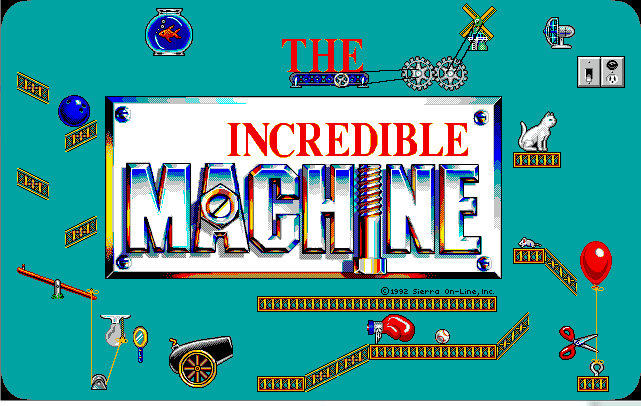
Oh this looks neat!
In the summer of 1992 when I was partway through implementing the original group of parts in The Incredible Machine, I read about Edward Fredkin and Tommaso Toffoli's Billiard Ball Computer. Roger Penrose also discussed it in his book The Emperor's New Mind which I was reading at the time. Along with a technical description it had a nifty graphic showing a billiard ball model for an AND gate similar to the one pictured below.
[caption id="attachment_387" align="aligncenter" width="400"]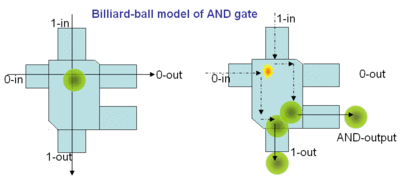 Modeling an AND gate with Billiard Balls[/caption]
Modeling an AND gate with Billiard Balls[/caption]
Wow, that would be cool to implement! I realized that I already had the basic physics and collision frameworks in place and I could implement the needed parts in TIM without too much effort. Walls, incline, and balls were already working. Finding enough free time before shipping would be the constraint on whether I could get it done in time by the ship date or not. TIM had a very tight development schedule.
Coding The Incredible Machine
Coding on TIM started on March 26, 1992. I know that exact date from the title page of my design. On the day that I finished the design, I wrote the date on the title page, printed it out, went “whew, finally” and then immediately started coding in the unheated and unfinished basement of my home in Eugene. Note: this was not my parents' basement – I was married and had three young kids at the time. Once I week I'd walk over to Jeff Tunnell's office with the latest build on a floppy disk and show the build to everyone.
[caption id="attachment_388" align="aligncenter" width="500"] Title page of the original design.[/caption]
Title page of the original design.[/caption]
Collision System
The first order of business when I started coding was getting a collision system in place. No Google, no big Internet search space, so I ended up writing the collision code from scratch. I decided to go with polygon borders for all the parts. Everything had to be integers because at the time the speed of floating point operations on CPUs was slow.
The conversion factor for the 16-bit integers was: 1,024 in the physics space was equal to 1 in the screen space. A shift of 10 bits left or right would convert between the two coordinate systems. The 360 degrees of a circle were covered by 16-bits and went from 0 (0 degrees) to 65536 (360 degrees). In hex it came out as: 0x0000 flat facing up, 0x4000 vertical on left, 0x08000 flat facing down, and 0xc0000 vertical facing left.
All the parts collision shapes were defined by polygons which could be either concave or convex. The collision checks were line segment to line segment – projecting each point of the polygon to where the new position would be based upon the velocity, creating a line segment, and checking for collisions with other polygons. If a collision was found, then the projected line would be adjusted to the point of first collision.
As an aside, there are now terms for most all of this stuff which in many cases didn't exist at the time. Lots of ad-hoc development here – making it up as I went along. So the segment-to-segment check would be what is now called swept collisions. There was also a broad-phase collision check. The way collisions were implemented allowed me to do a bit check on the high bit and reject roughly half the checks – less calculations – important because frame rate was a big concern. The fastest code is the code that isn't executed.
The collision polygons for the Balloon and Birdcage became my debug test cases. I created graph paper version that exactly matched how they were represented in the game data. I would move the paper cutouts around by hand in various collision scenarios to verify that the code was working correctly. The hex values in the balloon and birdcage photos are the slopes of the line.
[caption id="attachment_391" align="aligncenter" width="549"]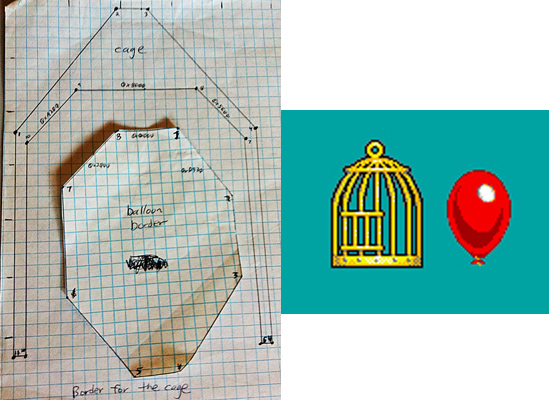 Balloon and Birdcage. Testing models and how they appeared in game.[/caption]
Balloon and Birdcage. Testing models and how they appeared in game.[/caption]
Physics Code
Written in parallel with the collision code was the physics code to apply forces to resolve collisions. Every part was a point mass with some parts being static and some dynamic. Each part had a density, mass, elasticity, friction, terminal velocity, and various other parameters. Sir Isaac Newton wrote the physics code for me roughly 300 years before TIM. I just had to put it in modern C code and make it fast and use only integers.
The structure for how the basic properties of the parts were defined is listed below. (Ugh, I don't like the code style I used back then). Those last elements in the struct are function pointers. They pointed to general routines for the parts and I would override them with pointers to specific functions for parts that needed them. TIM was written in C and this is similar to overridable methods in C++ although I wasn't familiar with C++ at the time.
struct part_elements { short density; short mass; short elasticity; short friction; short acel; short terminal_velocity; TIM_VEC max_size; TIM_VEC min_size; struct shape **part_shapes; SSHAPE **super_shapes; TIM_SCVEC *shp_offset; TIM_VEC *shape_size; unsigned char plane_num[2]; short num_borders; short part_bin_order; VOID_BPARTFPTR bounce_func; VOID_PARTFPTR internal_func; VOID_PARTFPTR reinit_func; VOID_FPARTFPTR flip_func; VOID_PARTFPTR resize_func; VOID_RPARTFPTR rope_func; };
So Where is the Billiard Ball Gate in TIM
Short answer: It's not there. I ran out of time.
Slightly longer answer: I really wanted to make an adder just like the picture below instead of just making an AND gate. Defining the elasticity and borders needed for the billiard balls would have been very quick and easy, but getting all the parts lined up correctly even for just the simpler AND gate would have been more time consuming than defining the needed parts.
[caption id="attachment_393" align="aligncenter" width="620"]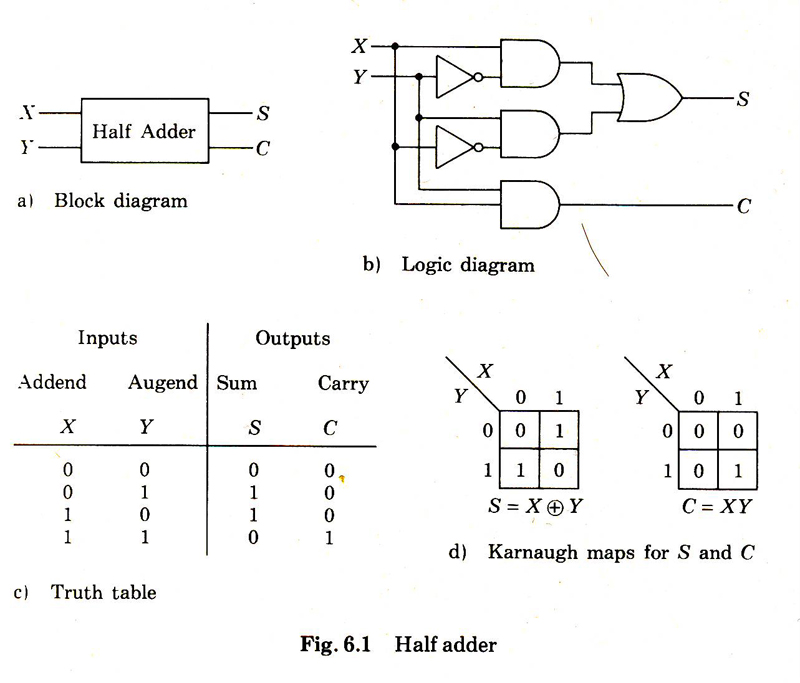 Diagram of an adder circuit.[/caption]
Diagram of an adder circuit.[/caption]
Game Dev Weight Loss Program
As best as I can remember, we shipped the first version of The Incredible Machine in mid-November of 1992. I remember that at the time getting to gold by mid-September was important for the Christmas season. Big orders by the distributors and stores were being made in September and then they'd duplicate a whole bunch of floppies and print up all the boxes. There was a lead time for all this so we would usually be shooting for mid-September to have a gold disk ready for shipment. It was a very bad thing to have bugs in the shipping floppy disk version because there was no simple way to get out an update.
So the summer of 1992 was a mix of implementing all the parts, tweaking the collision and physics code, and creating all the puzzles that would ship with the game. Creating new puzzles started becoming harder and harder. I was very busy and over that summer my weight dropped from 155 to a little below 140. It was fun! Really! I wouldn't still be doing games for all these years if it wasn't fun. But it was tiring too. Near the end of TIM development I started referring to it as a 6 month sprint.
[caption id="attachment_395" align="aligncenter" width="620"]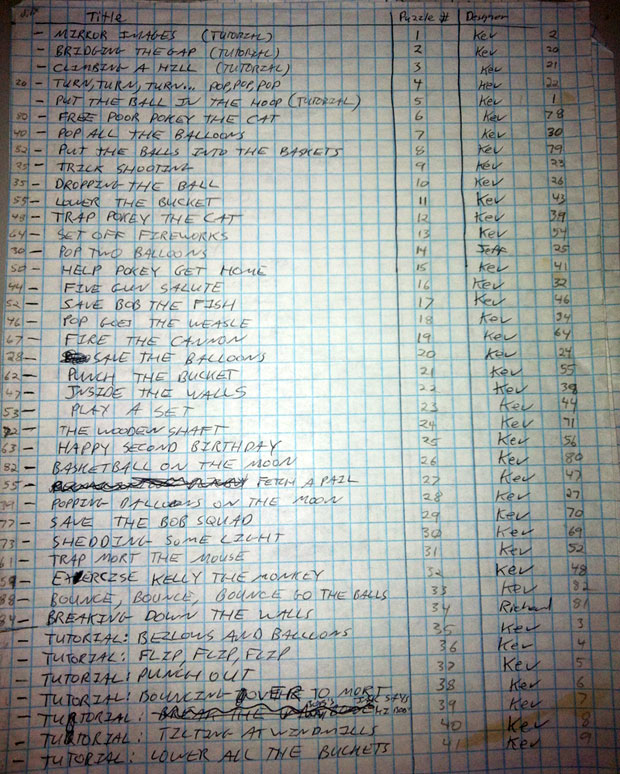 Some of the puzzles from TIM. I would go through them all and reorder how they showed up in game to gradually increase difficulty for the end users.[/caption]
Some of the puzzles from TIM. I would go through them all and reorder how they showed up in game to gradually increase difficulty for the end users.[/caption]
I just played the first version of TIM for the first time in a long time – a very long time. I had to buy it from the Good Old Games website because I don't have a running copy here. I see that Billiard Balls aren't even in the first version, but they did make it into the “Even More'” version where more parts and puzzles were added. And they aren't affected by gravity and are perfectly elastic so they had the correct physics attributes to implement the AND gate. But they would have still needed work to give each of them the exact same initial velocity when entering the gate and then there would have been lots of tweaking of position to get them working correctly.
Over the last year few of years I've been working on Contraption Maker with Spotkin. It is published on Steam and we continue to make updates for it. There is a different publishing paradigm in place. Now it is easy to do updates seamlessly to the end user. A Billiard Ball Computer is on my to-do list for Contraption Maker although the physics system being used would make it just a little harder because it doesn't use swept collisions. Maybe someday in an update I'll get it in there.
More Reading:
Conservative Logic a paper by Edward Fredkin and Tommaso Toffoli.

Top Meadow Inc
2 members Developer & PublisherFounded by over 3 decade industry veteran, Top Meadow is a developer and publisher of computer games.
